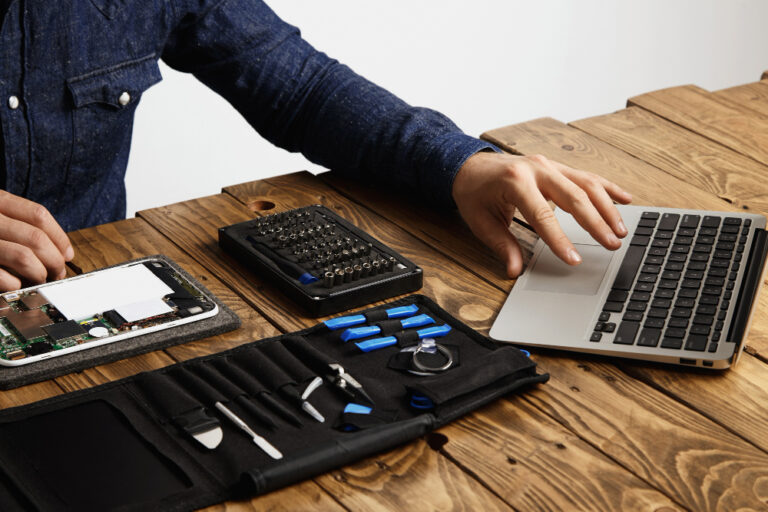It can be quite frustrating when you come across issues with your laptop but don’t worry; we’ve all been there. Whether you’re using a Mac or a PC, different devices can encounter problems. The key is to know how to fix this.
In this article, we’ll discuss a problem that Mac users might face. A trackpad on the MacBook isn’t functioning properly. And how to address it. We’ll provide some solutions for you to try before considering taking your device to an Apple service center.
Common Causes of Trackpad Issues on MacBooks
There are reasons why your MacBooks trackpad may be acting up, and it’s not always easy to pinpoint the cause without some investigation. However, there are some issues considering;
- Physical Damage– Accidents happen, and sometimes liquids spill on laptops or get accidentally dropped, leading to physical damage. Such damage can result in the trackpad not working correctly.
- Swollen Battery- If your MacBook battery swells, it can exert pressure on the trackpad, causing unresponsiveness.
- System Malfunction- Software glitches, hardware complications, or system malfunctions can also cause trackpad difficulties. Thankfully, in some instances, these problems can be rectified with solutions. Let’s delve into a few of these remedies.
How to Fix it
If you’ve observed that the trackpad on your MacBook is unresponsive. don’t panic just yet. Before rushing to the nearest Apple service center, try these free and simple solutions that might solve the problem.
- Check for Updates
It might sound surprising, but not Keeping your Mac’s operating system up to date can help avoid various issues. Before trying more complex troubleshooting, check if there are any macOS updates you may have missed. Installing the latest updates can often resolve software-related problems.
If updating the OS doesn’t help, adjusting your trackpad settings may fix things:
- Adjust Settings
- Go to System Preferences > Accessibility > Mouse & Trackpad and make sure “Enable Mouse Keys” is unchecked.
- In the Trackpad Options, find “Ignore built-in trackpad when Mouse Keys is on” and turn this off.
- Try increasing the Double-click speed setting.
- Disable the “Ignore built-in trackpad…” option if a wireless mouse is connected. This can interfere with the trackpad.
- Check the Tracking Speed in Trackpad settings. If it’s too low, the trackpad may feel unresponsive or laggy.
- Think about switching off Bluetooth in the event that you utilize a remote mouse, as this can in some cases cause trackpad issues.
- Reset SMC (System Management Controller)
- Resetting the SMC (System Management Controller) can also fix trackpad problems, as it controls essential Mac processes like the trackpad. Here’s how to reset it:
- Unplug the power cable and turn off the Mac.
- For models with a removable battery, take out the battery.
.Hold the power button for about 5 seconds. Reinsert the battery and let your computer power on as usual.
- For models without a removable battery:
- Press and hold the Ctrl + Left Shift + Option keys together with the power button for 10 seconds. Release the keys and turn your Mac back on.
- For 2018 MacBook Pro:
- Hold the Touch ID or power button for 10 seconds.
- Release it.
- Wait for another 10 seconds.
- Turn on your computer.
- Reset PRAM/NVRAM
PRAM and NVRAM store data about your Mac’s settings, and resetting them can help resolve software issues. Follow these steps:
Power off your computer.
Turn it back on and immediately hold Option + Command + P + R for about 20 seconds.
When you hear a second startup sound or see the Apple logo for the second time, release the keys and let your computer restart as usual.
- Check Hardware
Sometimes, trackpad issues can be connected with battery issues, for example, low charge levels or other power-related issues. On the off chance that you suspect this is the situation, it’s really smart to contact your closest help community for help.
- Delete Property List Files
If none of the above tips work, you can try deleting certain Property List (PLIST) files. Here are the main files to look for:
- com.apple.driver.AppleBluetoothMultitouch.trackpad.plistcom.apple.driver.AppleBluetoothMultitouch.mouse.plistcom.apple.driver.AppleHIDMouse.plistcom.apple.AppleMultitouchTrackpad.plistcom.apple.preference.trackpad.plist
Deleting any of these files won’t harm your system. It will force your Mac to recreate the lost files, which can sometimes resolve trackpad issues. After deleting these PLIST files, restart your computer and check if the problem is resolved.
These simple solutions should help you troubleshoot and fix common MacBook trackpad issues. Recollect that not all issues require a visit to the Apple administration focus, and you can frequently determine them all alone. Be that as it may, on the off chance that none of these means work, or on the other hand assuming you’re awkward playing out these investigating steps yourself, it’s generally really smart to look for proficient assistance from an approved help place.

